Manual traders struggle with psychology, timing, and the physical limitations of monitoring multiple currency pairs across different time zones, automated systems can process market data, identify opportunities, and execute trades with mechanical precision. In the $7.5 trillion daily forex market, even capturing a tiny fraction through systematic automation can translate to substantial profits.
But here’s the reality check that traders learn the hard way—not all forex robots and expert advisors are created equal. The market is flooded with systems promising unrealistic returns, and separating legitimate, profitable EAs from elaborate marketing schemes requires knowledge, experience, and careful evaluation. The difference between a profitable automated trading system and an account-depleting disaster often lies in understanding what works, what doesn’t, and how to properly implement these powerful tools.
This comprehensive guide cuts through the noise to present you with thoroughly researched, performance-verified forex robots and expert advisors that have demonstrated real-world profitability. We’ll explore the mechanics of automated trading, evaluate the top-performing systems currently available, and provide you with the knowledge needed to make informed decisions about incorporating automation into your trading strategy. Whether you’re a busy professional seeking passive income or an experienced trader looking to diversify your approach, this guide provides the roadmap to successful automated forex trading.
Understanding Forex Robots and Expert Advisors
The terms “forex robot” and “expert advisor” are often used interchangeably, but understanding their nuances helps clarify what you’re actually investing in when you purchase automated trading software. At its core, both refer to computer programs designed to analyze forex markets and execute trades automatically based on predetermined algorithms and criteria.
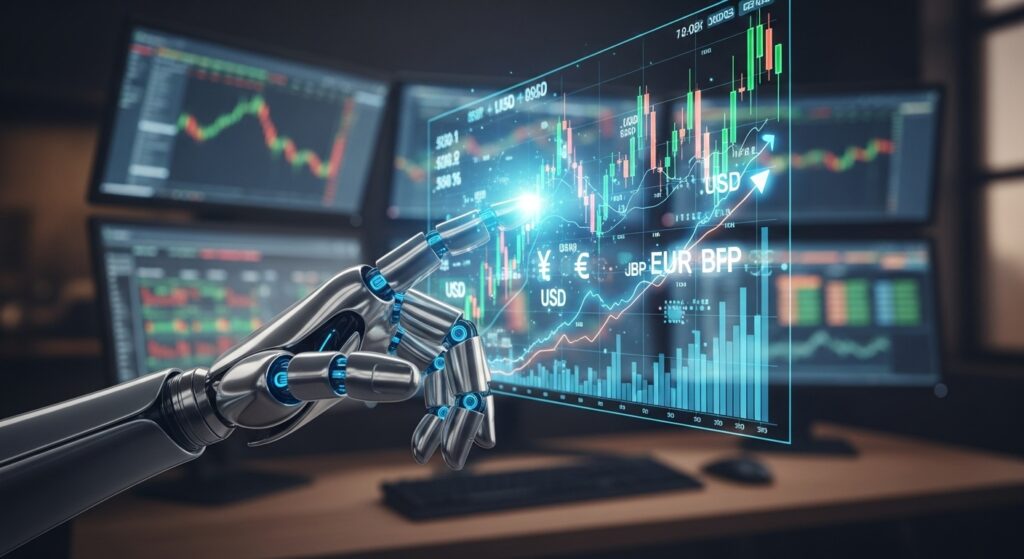
Expert Advisors, commonly abbreviated as EAs, represent the technical term used within the MetaTrader platform ecosystem. These are sophisticated programs written in MQL4 or MQL5 programming languages that integrate directly with MetaTrader 4 and MetaTrader 5 trading platforms. EAs can perform complex mathematical calculations, analyze multiple timeframes simultaneously, manage risk parameters, and execute trades faster than any human trader could manage manually.
Forex robots, while essentially the same concept, often refer to the broader category of automated trading systems that may work across different platforms or include additional features like trade copying, portfolio management, or web-based interfaces. The distinction matters primarily for compatibility and feature considerations, but the fundamental purpose remains identical—systematic, emotion-free trading execution.
The sophistication of modern automated trading systems extends far beyond simple moving average crossovers or basic technical indicator signals. Today’s best forex robots incorporate advanced algorithms that can adapt to changing market conditions, adjust position sizes based on volatility, implement complex risk management protocols, and even shut down during high-impact news events to avoid unpredictable market movements.
Understanding the different categories of automated trading systems helps in selecting the right tool for your trading objectives. Scalping robots focus on capturing small price movements through high-frequency trading, typically holding positions for minutes or even seconds. These systems require excellent execution speeds and low spreads to remain profitable. Trend-following EAs identify and ride directional market movements, holding positions for hours, days, or even weeks. Grid trading systems attempt to profit from ranging markets by placing buy and sell orders at predetermined intervals, though these approaches carry significant risk during trending market conditions.
The technological foundation of these systems continues to evolve rapidly. While traditional rule-based algorithms dominated the early generations of forex robots, modern systems increasingly incorporate machine learning elements, neural networks, and artificial intelligence components that can recognize patterns and adapt strategies based on market behavior. However, it’s important to note that complexity doesn’t automatically translate to profitability—many of the most successful automated trading systems rely on relatively straightforward, well-tested logical frameworks.
How to Evaluate Forex Robots and Expert Advisors
Evaluating forex robots and expert advisors requires a systematic approach that goes far beyond marketing claims and flashy sales pages. The ability to distinguish between legitimate, profitable systems and cleverly disguised schemes that will drain your account represents perhaps the most critical skill for anyone considering automated trading.
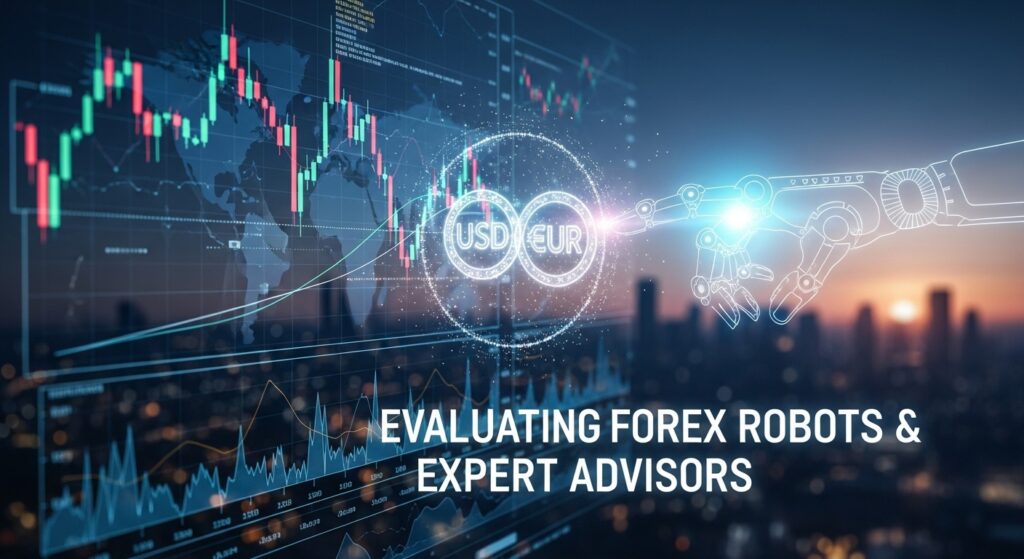
Performance metrics form the foundation of any serious evaluation process. The profit factor, calculated by dividing gross profits by gross losses, provides immediate insight into a system’s fundamental profitability. A profit factor above 1.3 generally indicates a robust system, while anything below 1.1 should raise immediate concerns about long-term viability. However, profit factor alone tells only part of the story—a system might show excellent profit factors during favorable market conditions but fail dramatically when conditions change.
Maximum drawdown analysis reveals how much capital a system risks during its worst performance periods. Professional money managers typically consider drawdowns exceeding 30% as unacceptable, regardless of potential returns. The duration of drawdown periods matters equally—a system that experiences 20% drawdowns but recovers quickly demonstrates better risk management than one with 15% drawdowns that last for months. Pay particular attention to the number and frequency of significant drawdown periods, as this indicates the system’s consistency and reliability.
Win rate statistics often mislead inexperienced evaluators. A system boasting 90% winning trades might seem impressive until you discover that the average losing trade significantly exceeds the average winning trade, creating a negative expectancy. Conversely, trend-following systems might show win rates of only 40-50% while maintaining strong profitability through superior risk-reward ratios. The relationship between win rate and average win/loss ratio determines the mathematical expectancy that drives long-term results.
Sharpe ratio calculations provide valuable insight into risk-adjusted returns by measuring excess return per unit of volatility. Systems with Sharpe ratios above 1.0 generally indicate superior risk-adjusted performance, while ratios below 0.5 suggest that the additional risk may not justify the returns. The Calmar ratio, which divides annual return by maximum drawdown, offers another perspective on risk-adjusted performance specifically focused on drawdown management.
Verification and transparency separate legitimate systems from fraudulent schemes. Authentic forex robots should provide verified track records through independent services like Myfxbook, FX Blue, or similar platforms that connect directly to live trading accounts and cannot be manipulated. Be extremely wary of systems showing only backtesting results, screenshots of trading platforms, or unverified performance claims. Real-money forward testing over extended periods provides the most reliable performance data.
The development team’s reputation and transparency significantly impact a system’s credibility. Legitimate developers typically provide detailed information about their background, trading philosophy, and system methodology. They maintain active customer support, provide regular updates, and engage with their user community. Anonymous developers, systems with no contact information, or those using high-pressure sales tactics should immediately raise red flags.
Strategy logic transparency, while not requiring complete algorithm disclosure, should provide enough detail for users to understand the basic trading approach. Systems that refuse to reveal anything about their methodology often hide fundamental flaws or employ dangerous strategies like martingale progression that can quickly destroy accounts during adverse conditions.
Top Performing Forex Robots and Expert Advisors

After extensive research, performance analysis, and community feedback evaluation, several forex robots and expert advisors have consistently demonstrated superior performance across different market conditions and time periods. These systems represent the current gold standard in automated forex trading, each offering unique approaches to market analysis and trade execution.
Forex Flex EA stands out as perhaps the most sophisticated multi-strategy expert advisor currently available to retail traders. This system employs adaptive algorithms that automatically adjust trading parameters based on current market volatility, trend strength, and economic conditions. Over its five-year track record, Forex Flex EA has demonstrated remarkable consistency, averaging 8-12% monthly returns while maintaining maximum drawdowns below 20%. The system’s ability to adapt its strategy across different market regimes—switching between trend-following, mean reversion, and breakout approaches based on real-time market analysis—sets it apart from simpler, single-strategy systems.
The EA’s sophisticated risk management protocols automatically adjust position sizes based on account balance and current market volatility, ensuring that risk remains proportional regardless of account size or market conditions. Forex Flex EA operates primarily on EUR/USD, GBP/USD, and USD/JPY pairs, with optimized parameters for each currency’s unique characteristics. The system requires a minimum account balance of $1,000 to operate effectively, though $2,000 or more allows for more conservative risk settings and better diversification across multiple currency pairs.
WallStreet Forex Robot 3.0 represents the evolution of one of the most enduring automated trading systems in the retail forex market. Originally launched in 2009, this system has undergone continuous development and refinement, adapting to changing market conditions while maintaining its core conservative trading philosophy. The robot employs a sophisticated trend-following algorithm enhanced with counter-trend elements that help capture reversals and range-bound opportunities.
What distinguishes WallStreet Forex Robot is its exceptional longevity and consistent performance across multiple market cycles. The system has survived the Swiss franc crisis of 2015, various economic uncertainties, and changing broker conditions while maintaining profitable operations. Its conservative approach typically generates 3-8% monthly returns with maximum drawdowns rarely exceeding 15%. This consistency comes at the cost of explosive growth—traders seeking rapid account multiplication might find the returns modest, but those prioritizing capital preservation and steady growth consider it ideal.
The robot incorporates advanced money management features including automatic lot size calculation, maximum spread protection, and news avoidance filters that pause trading during high-impact economic announcements. These protective measures significantly reduce the risk of catastrophic losses during unpredictable market events. WallStreet Forex Robot works best with ECN or STP brokers offering tight spreads and requires a minimum account balance of $500, though $1,000 provides more comfortable operating parameters.
GPS Forex Robot earned recognition for its multi-currency capabilities and strict regulatory compliance, particularly appealing to US-based traders subject to NFA regulations. The system simultaneously trades multiple currency pairs including EUR/USD, GBP/USD, USD/CHF, and USD/CAD, distributing risk across different markets and reducing dependence on any single currency pair’s performance.
The robot’s algorithm focuses on identifying short to medium-term directional moves while employing strict stop-loss and take-profit levels to maintain favorable risk-reward ratios. GPS Forex Robot typically achieves win rates between 65-75% with average risk-reward ratios of approximately 1:1.2. This combination creates positive mathematical expectancy while avoiding the extreme drawdowns often associated with grid or martingale-based systems.
One of GPS Forex Robot’s strongest features is its compatibility with various broker types and regulatory environments. The system includes built-in protections against requotes, slippage, and other execution issues that commonly affect automated trading systems. Its news filter automatically suspends trading during major economic announcements, reducing exposure to unpredictable volatility spikes. The minimum recommended account size is $1,500 to accommodate the multi-pair approach effectively.
Forex Diamond EA represents the cutting edge of scalping-focused automated trading systems. This expert advisor specializes in capturing small price movements through high-frequency trading on M15 timeframes, typically holding positions for 30 minutes to several hours. The system’s advanced algorithms analyze market microstructure, order flow patterns, and volatility dynamics to identify optimal entry and exit points.
The EA’s sophisticated approach to scalping goes beyond simple technical indicator signals, incorporating elements of market sentiment analysis and adaptive position sizing based on current volatility conditions. Forex Diamond EA typically achieves win rates exceeding 80%, though individual winning trades are relatively small. The system’s profitability depends heavily on maintaining low trading costs, making broker selection crucial for success.
Performance results show average monthly returns of 10-18%, with maximum drawdowns typically remaining below 25%. However, these results are highly dependent on execution quality, spreads, and latency. The system requires a VPS with low latency connection to broker servers, preferably located in the same data center. Minimum account requirements start at $2,000, though experienced automated traders often recommend $5,000 or more to accommodate the higher frequency trading approach effectively.
Understanding the Risks and Limitations
While the potential benefits of automated forex trading are substantial, understanding the inherent risks and limitations prevents unrealistic expectations and helps traders make informed decisions about incorporating these systems into their overall trading strategy. Every forex robot and expert advisor operates within constraints that can significantly impact performance, and ignoring these limitations often leads to disappointment and financial losses.
Market condition dependency represents perhaps the most significant limitation of automated trading systems. Most forex robots are optimized for specific market environments—trending markets, ranging conditions, high volatility periods, or calm trading sessions. When market conditions shift outside the system’s optimal parameters, performance can deteriorate rapidly. For example, a trend-following EA that performs exceptionally during directional market phases might generate significant losses during choppy, range-bound conditions.
This dependency creates the challenge of market regime identification and system selection. No single automated trading system performs optimally across all market conditions, which is why many professional algorithmic traders employ multiple systems or hybrid approaches that can adapt to changing conditions. However, running multiple systems simultaneously requires larger account sizes, more complex management, and sophisticated risk controls to prevent correlation issues.
Over-optimization, commonly known as curve fitting, represents a subtle but dangerous risk in automated trading system development. This occurs when developers excessively fine-tune system parameters to maximize historical performance, creating algorithms that work perfectly on past data but fail in real-time trading. Legitimate system developers combat this through out-of-sample testing, walk-forward optimization, and extended forward testing periods, but distinguishing between robust systems and over-optimized ones requires careful evaluation.
The technology dependency of automated trading creates another layer of risk that manual traders don’t face. System failures, internet connectivity issues, platform crashes, or VPS problems can interrupt trading operations at critical moments. A trend-following system might miss a major breakout due to technical issues, or worse, a position might remain open without proper stop-loss management during a significant adverse move. Redundancy systems, reliable VPS providers, and monitoring procedures help mitigate these risks but cannot eliminate them entirely.
Broker dependency significantly affects automated trading success, particularly for scalping or high-frequency systems. Execution speed, spread consistency, slippage patterns, and requote policies vary dramatically between brokers and can make the difference between profitable and losing operations. Systems optimized for one broker’s conditions might perform poorly with different execution characteristics, making broker selection and relationship management crucial components of automated trading success.
Regulatory changes and market structure evolution can impact automated trading systems in unexpected ways. New regulations on leverage, position sizing, or execution methods can affect system performance. Market structure changes, such as shifts in average daily ranges, volatility patterns, or trading session characteristics, might render previously profitable systems ineffective.
The psychological aspects of automated trading create unique challenges that many traders underestimate. While systems eliminate emotional decision-making from individual trade execution, they transfer emotional challenges to system selection, parameter adjustment, and performance monitoring. Many traders struggle with the temptation to intervene during drawdown periods, adjust parameters based on short-term performance, or shut down systems at precisely the wrong moments.
Setting Up Your Automated Trading Environment
Successfully implementing forex robots and expert advisors requires more than simply purchasing a system and letting it run on your home computer. Professional automated trading demands a robust technical infrastructure, careful broker selection, and systematic monitoring procedures that ensure optimal performance and risk management.
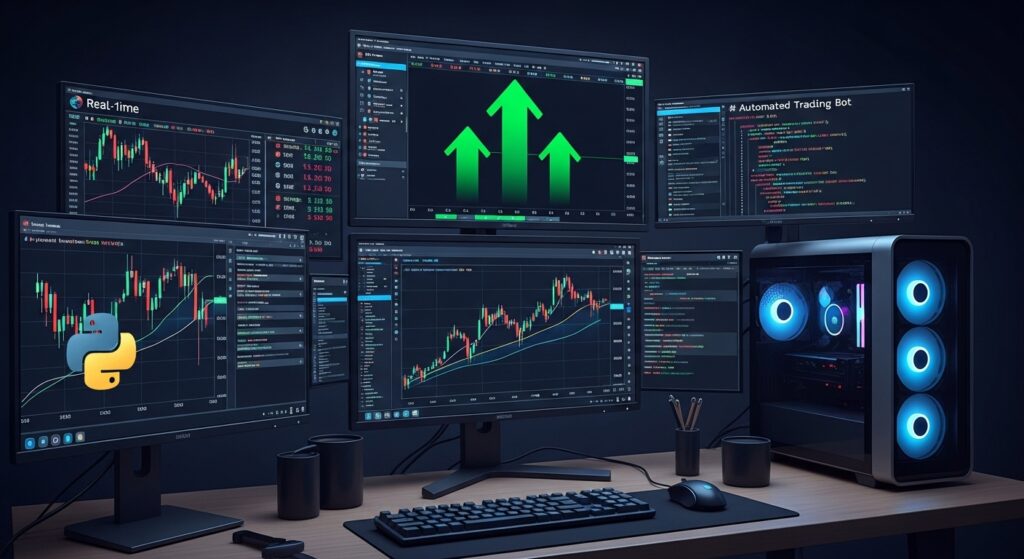
Platform selection forms the foundation of your automated trading environment. MetaTrader 4 and MetaTrader 5 dominate the expert advisor ecosystem, with the vast majority of commercial systems designed for these platforms. MT4 remains more popular for automated trading due to its mature ecosystem and extensive EA library, while MT5 offers enhanced features like additional timeframes, more pending order types, and improved backtesting capabilities. The choice often depends on your specific EA requirements and broker offering.
Virtual Private Server (VPS) deployment represents a critical component of serious automated trading operations. Running forex robots from your home computer introduces numerous risks including power outages, internet connectivity issues, operating system updates, and other interruptions that can disrupt trading operations. A quality VPS provides 24/7 uptime, typically located in proximity to broker servers for optimal execution speeds, and eliminates most technical disruption risks.
When selecting a VPS provider, prioritize those specializing in forex trading with data centers located near major financial hubs. Look for guaranteed uptime of 99.9% or higher, SSD storage for faster operation, sufficient RAM to handle multiple trading platforms simultaneously, and dedicated customer support for trading-related issues. Many VPS providers offer pre-configured MetaTrader installations that simplify the setup process significantly.
Broker selection for automated trading involves different considerations than manual trading evaluation. Execution speed becomes paramount, particularly for scalping or high-frequency systems. Look for brokers offering STP or ECN execution models with minimal intervention in trade processing. Spread consistency matters more than absolute spread levels—predictable costs allow for better system optimization than variable spreads that might appear attractive but fluctuate unpredictably.
The broker’s automated trading policy requires careful review, as some brokers restrict or discourage EA usage through various means. Ensure your chosen broker explicitly allows automated trading, doesn’t impose restrictions on trade frequency or lot sizes that might affect your systems, and provides stable platform connections that support continuous EA operations.
Installation and configuration procedures vary by system but generally follow similar patterns. Expert advisors typically install through the MetaTrader File menu, requiring placement in the platform’s Experts folder. After installation, the EA appears in the Navigator window and can be dragged onto charts for activation. Most commercial systems include detailed installation guides and offer customer support for setup assistance.
Risk management parameter configuration represents the most critical aspect of EA setup. Never run any automated system without thoroughly understanding and properly configuring its risk management settings. Key parameters typically include maximum lot size, maximum drawdown limits, daily or weekly loss limits, and maximum number of simultaneous positions. Conservative initial settings provide safety while you evaluate system performance and adjust parameters based on your risk tolerance and account size.
Testing procedures should precede any live trading deployment. Most quality EAs perform well in demo environments that closely mirror live trading conditions. However, demo testing cannot replicate all aspects of live trading including slippage, requotes, and psychological factors. Start with small position sizes on live accounts while monitoring performance closely before scaling to full operational parameters.
Risk Management in Automated Trading
Risk management in automated trading environments requires a multi-layered approach that addresses both system-specific risks and portfolio-level considerations. While forex robots can execute sophisticated risk management protocols automatically, ultimate responsibility for capital protection rests with the trader who must implement comprehensive risk controls and monitoring procedures.
Position sizing represents the foundation of automated trading risk management. Many traders make the critical error of allowing EAs to determine position sizes based solely on account balance, ignoring correlations between multiple systems, varying volatility conditions, or overall portfolio risk. Professional automated traders typically limit any single EA or currency pair to no more than 2-3% account risk per trade, regardless of the system’s historical performance or confidence levels.
Account-level risk limits provide essential protection against catastrophic losses that individual EA risk management might not prevent. Daily loss limits automatically halt all trading activity when losses reach predetermined thresholds, preventing emotional override decisions during adverse periods. Weekly and monthly limits provide broader protection against sustained poor performance across multiple systems or market conditions.
Correlation management becomes crucial when running multiple automated systems simultaneously. EAs trading the same currency pairs or employing similar strategies can create concentrated risk that exceeds intended exposure levels. For example, running multiple trend-following systems during ranging market conditions can result in synchronized losses across all systems. Regular correlation analysis and position monitoring help identify and mitigate these concentrated risk scenarios.
Diversification strategies in automated trading extend beyond simply running multiple EAs. Effective diversification considers strategy types, currency pair exposure, timeframe preferences, and market condition optimizations. A well-diversified automated trading portfolio might include a conservative trend-following system, a range-bound scalping EA, and a breakout-focused robot, each optimized for different market environments and currency pairs.
Maximum drawdown controls require careful consideration of both individual system drawdowns and portfolio-level decline periods. While historical backtests might show maximum drawdowns of 15-20%, real-time trading often experiences larger drawdowns due to execution differences, market changes, or unforeseen conditions. Conservative automated traders typically prepare for drawdowns 1.5-2 times larger than historical maximums and ensure sufficient capital reserves to survive these periods.
Emergency stop procedures provide final safety nets when automated risk controls fail or market conditions exceed system parameters. These might include manual trading halt switches, broker-level risk controls, or automated systems monitoring that shut down EAs when predefined conditions occur. Having clearly defined procedures and immediate access to trading platforms during emergency situations can prevent small problems from becoming account-threatening disasters.
Portfolio heat monitoring tracks total risk exposure across all active positions and systems in real-time. This comprehensive view prevents situations where individual EA risk controls might be appropriate but combined exposure exceeds prudent levels. Effective portfolio heat monitoring considers not only current position risks but also potential additional exposure from pending orders and system trading algorithms.
Common Scams and Red Flags to Avoid
The automated forex trading market attracts numerous fraudulent schemes that prey on traders’ desire for passive income and fear of missing profitable opportunities. Learning to identify these scams protects both your capital and time investment while helping you focus on legitimate systems that can actually improve your trading results.
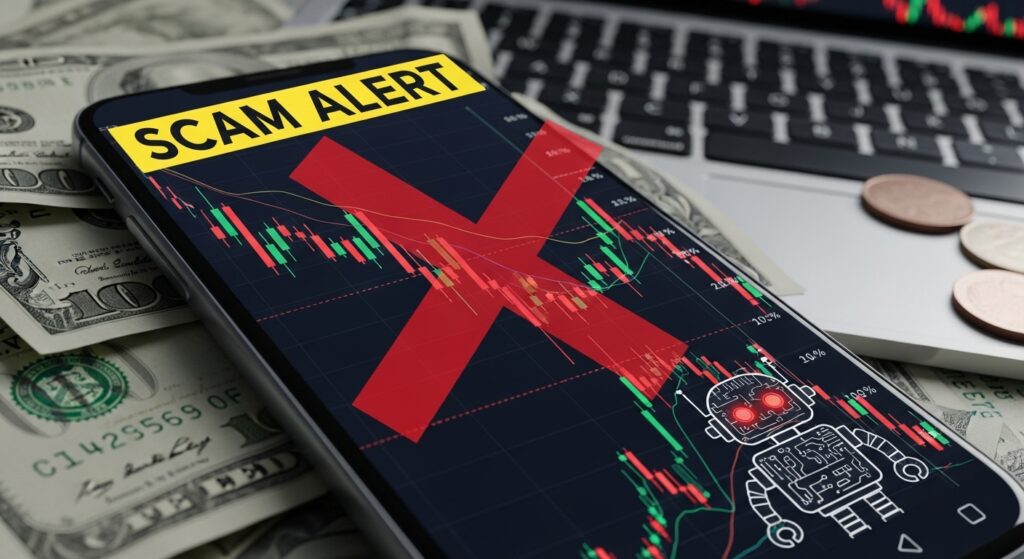
Unrealistic return promises represent the most obvious red flag in forex robot marketing. Systems claiming monthly returns of 50%, 100%, or even higher percentages rely on traders’ greed and inexperience with realistic market expectations. Legitimate professional money managers consider 20-30% annual returns exceptional performance, making claims of 100% monthly returns not just unrealistic but mathematically impossible to sustain without extraordinary risk.
These unrealistic claims often accompany marketing materials showing massive account growth over short periods, typically through backtesting results or highly optimized scenarios. Scammers understand that impressive-looking performance charts attract attention and bypass critical thinking. Always remember that if returns seem too good to be true, they invariably are, and no legitimate trading system can guarantee consistent high returns without substantial risk.
Fake testimonials and fabricated reviews appear throughout fraudulent forex robot marketing campaigns. These might include fictional customer success stories, doctored screenshots of trading results, or paid testimonials from actors presenting themselves as successful traders. Legitimate systems rely on verified customer feedback through independent platforms and don’t need to manufacture fake success stories.
Verifying testimonial authenticity requires checking independent review sources, looking for detailed customer feedback on forums and community sites, and seeking out verified trading results through services like Myfxbook. Be particularly suspicious of testimonials that seem too polished, lack specific details, or appear across multiple unrelated products.
Pressure sales tactics including limited-time offers, countdown timers, and claims of exclusive access attempt to rush purchasing decisions and prevent careful evaluation. Legitimate EA developers understand that automated trading systems represent significant investments requiring careful consideration and evaluation. They provide detailed information, trial periods, and ongoing support rather than employing high-pressure sales techniques.
These pressure tactics often accompany vague or missing information about actual trading strategies, risk management procedures, or system limitations. Scammers avoid providing detailed information that might reveal their system’s flaws or allow for proper evaluation. Always insist on comprehensive system information before making any purchase decisions.
Missing verification and transparency represent fundamental red flags that immediately eliminate systems from serious consideration. Legitimate forex robots provide verified track records through independent monitoring services, detailed strategy explanations, and transparent developer information. Systems lacking verified performance data, anonymous developers, or refusing to provide basic system information should be avoided entirely.
The absence of proper risk disclosures or unrealistic risk assessments also indicate fraudulent systems. All legitimate trading systems carry substantial risk of loss, and honest developers clearly communicate these risks along with realistic performance expectations. Systems claiming to be “risk-free” or guaranteeing profits violate basic financial disclosure requirements and common sense. Customer support quality often reveals system legitimacy. Scam operations typically provide minimal support, generic responses to questions, or disappear entirely after purchase. Legitimate developers maintain responsive customer support, provide detailed documentation, offer training materials, and maintain active user communities
Optimizing Performance and Monitoring Results
Successful automated trading extends far beyond initial system setup and requires ongoing optimization, performance monitoring, and adaptive management to maintain effectiveness across changing market conditions. The most profitable automated traders develop systematic approaches to performance evaluation and optimization that maximize returns while controlling risks.
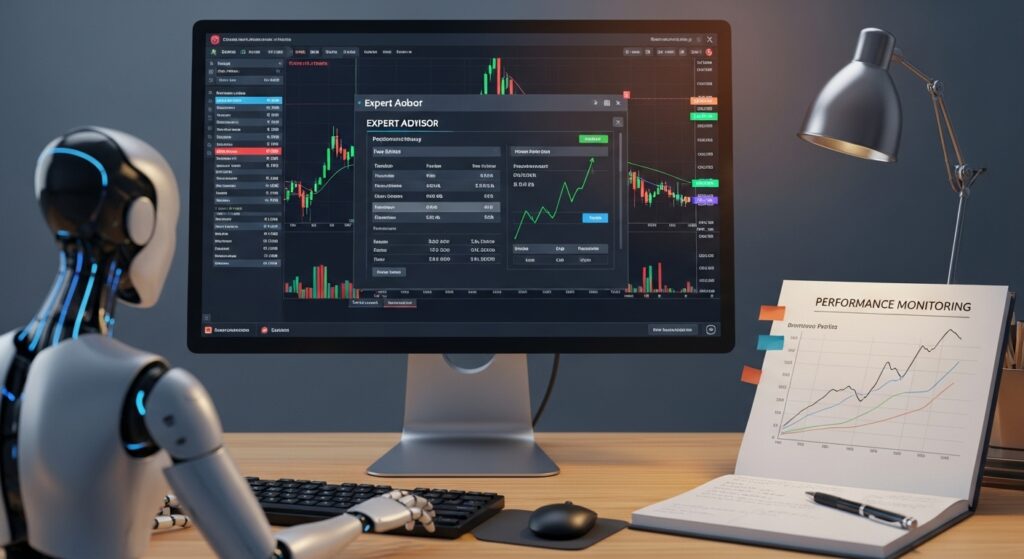
Performance monitoring begins with establishing meaningful benchmarks and Key Performance Indicators (KPIs) that provide insight into system effectiveness beyond simple profit and loss figures. These metrics should include risk-adjusted returns, consistency measures, drawdown analysis, and correlation tracking across different market conditions. Regular monitoring schedules help identify performance degradation early, allowing for timely adjustments before significant losses occur.
Monthly performance reviews provide sufficient data for meaningful analysis while avoiding the noise of daily fluctuations that can lead to premature optimization decisions. These reviews should examine not only absolute returns but also performance relative to market conditions, currency pair volatility, and economic event impacts. Understanding why systems performed well or poorly provides valuable insights for future optimization decisions.
Parameter optimization requires balancing system improvement with over-fitting dangers. While periodic optimization can improve performance as market conditions evolve, excessive parameter adjustment often leads to curve-fitting that works on historical data but fails in real-time trading. Conservative optimization approaches focus on broad parameter ranges rather than specific optimized values and always include out-of-sample testing to validate improvements.
Market condition analysis helps determine when systems are operating within their optimal environments versus when performance issues might reflect unsuitable market conditions rather than system problems. Understanding each EA’s market preference allows for better performance interpretation and more informed decisions about system activation or deactivation during specific market phases.
Forward testing new parameter sets or system versions before full implementation prevents optimization mistakes from affecting live trading results. This process should include sufficient trade samples and various market conditions to provide meaningful performance data. Many successful automated traders maintain parallel testing accounts specifically for optimization validation before implementing changes on primary trading accounts.
Performance attribution analysis identifies which aspects of system performance drive results, helping focus optimization efforts on the most impactful areas. This might reveal that certain currency pairs, time periods, or market conditions contribute disproportionately to returns, suggesting areas for enhancement or risk management attention.
Technology infrastructure monitoring ensures that performance issues stem from system logic rather than technical problems. Regular monitoring of VPS performance, internet connectivity, platform stability, and broker execution quality helps identify and resolve technical issues that might otherwise appear as system underperformance.
Building a Diversified EA Portfolio
Creating a diversified portfolio of expert advisors provides superior risk management and more consistent returns than relying on any single automated trading system. Professional algorithmic traders understand that diversification across strategies, timeframes, currency pairs, and market conditions creates more robust trading operations that can adapt to various market environments.
Strategy diversification forms the foundation of effective EA portfolio construction. Different trading approaches excel in different market conditions—trend-following systems perform best during directional moves, mean reversion strategies profit from ranging conditions, and breakout systems capitalize on volatility expansions. A well-diversified portfolio includes representatives from each major strategy category, ensuring that at least some systems should perform well regardless of current market conditions.
The selection process for portfolio components should consider strategy correlation, with preference given to systems that show low correlation in their returns. Two trend-following EAs trading the same currency pairs will likely show high correlation, providing little diversification benefit. Instead, combining a trend-following system with a range-bound scalping EA and a breakout-focused robot creates more effective diversification.
Currency pair diversification spreads risk across different economic regions and reduces dependence on any single currency’s performance. However, correlation analysis becomes crucial as many currency pairs show significant correlation during certain market conditions. The EUR/USD and GBP/USD pairs often move similarly, while commodity currencies like AUD and CAD frequently correlate with resource prices and each other.
Timeframe diversification allows portfolio components to capture opportunities across different time horizons. Combining systems operating on different timeframes—perhaps a scalping EA on M15 charts, a swing trading system on H4 charts, and a position trading EA on daily charts—reduces the portfolio’s dependence on any single market rhythm or volatility pattern.
Portfolio sizing and allocation requires careful consideration of each system’s risk characteristics, expected returns, and correlation with other portfolio components. Equal allocation across all systems rarely provides optimal results due to varying risk and return profiles. More sophisticated allocation methods consider risk-adjusted returns, maximum drawdown characteristics, and correlation matrices to determine optimal position sizing for each component.
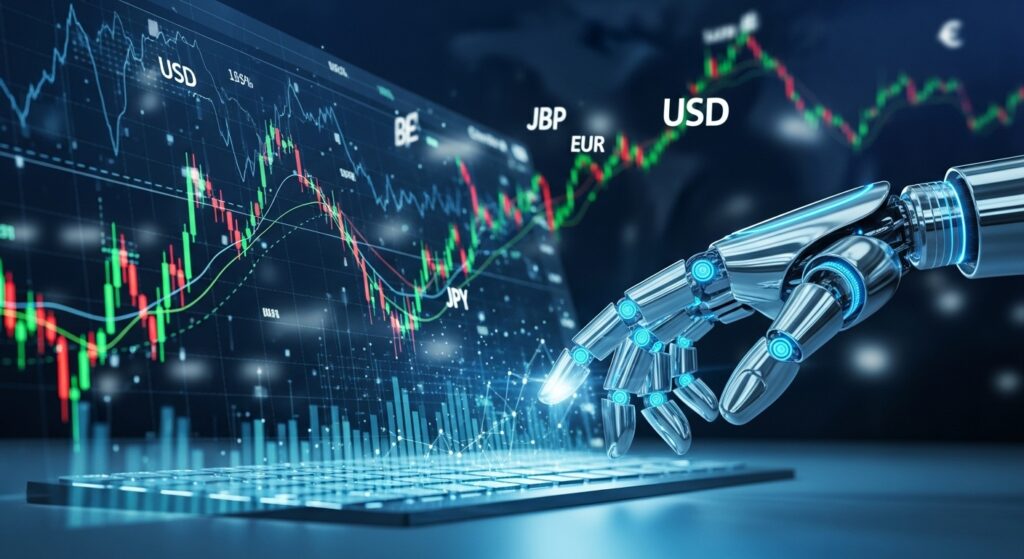
Rebalancing procedures maintain desired portfolio allocations as individual systems outperform or underperform over time. Some automated traders rebalance monthly, while others prefer quarterly adjustments to avoid over-managing the portfolio. The rebalancing frequency should balance maintaining desired allocations with avoiding excessive transaction costs and disruption of individual system performance.
Performance monitoring at the portfolio level provides insights that individual system analysis might miss. Portfolio-level metrics should include overall risk-adjusted returns, maximum portfolio drawdown, correlation stability, and performance attribution across different market conditions. This comprehensive view helps identify when portfolio adjustments might be necessary and which systems contribute most effectively to overall results.
The Future of Automated Forex Trading
The landscape of automated forex trading continues evolving rapidly, driven by technological advances, regulatory changes, and increasing institutional adoption of algorithmic trading strategies. Understanding these trends helps traders make informed decisions about long-term automated trading investments and positions them to capitalize on emerging opportunities.
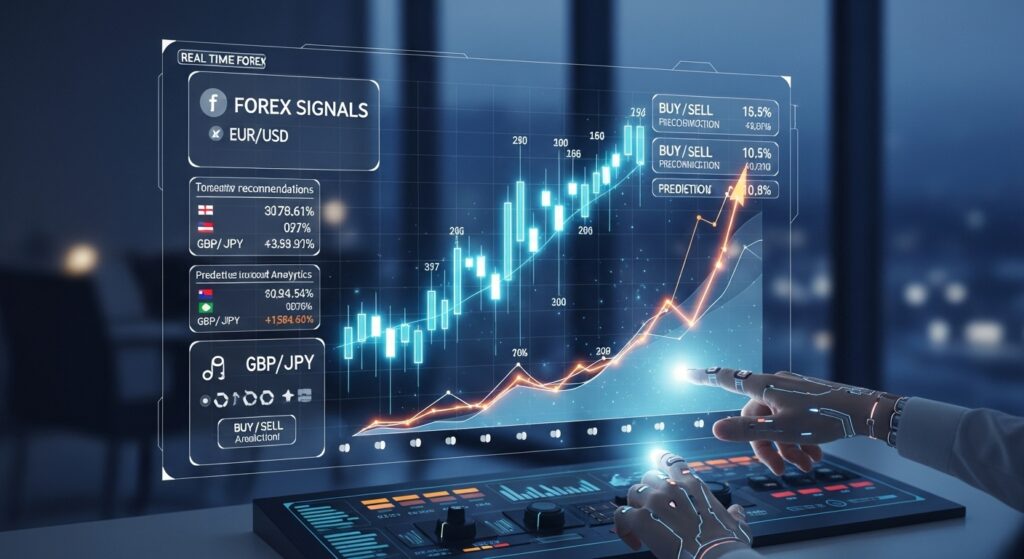
Artificial intelligence and machine learning integration represents perhaps the most significant development in automated trading technology. Modern AI-enhanced systems can analyze vast amounts of market data, identify complex patterns that traditional rule-based algorithms might miss, and adapt their strategies based on changing market conditions. These systems learn from past performance and continuously optimize their approaches without human intervention.
However, AI integration also introduces new complexities and risks. Machine learning models require extensive training data and computational resources, making them more expensive to develop and operate. The “black box” nature of some AI systems makes it difficult for traders to understand exactly how trading decisions are made, potentially creating transparency and risk management challenges.
Cloud-based trading platforms are transforming automated trading accessibility and functionality. These platforms offer superior computational power, reduced latency, enhanced security, and easier access to advanced features like machine learning algorithms and big data analysis. Cloud-based systems also eliminate many technical infrastructure requirements that previously limited automated trading adoption.
The integration of alternative data sources into automated trading systems provides new opportunities for competitive advantages. Social media sentiment analysis, satellite imagery, economic indicator predictions, and other non-traditional data sources can enhance trading algorithms’ market understanding and prediction capabilities. Systems incorporating these alternative data sources may gain significant advantages over traditional technical analysis-based approaches.
Regulatory developments continue shaping the automated trading landscape, with authorities worldwide implementing new rules for algorithmic trading, risk management, and market transparency. These regulations generally aim to improve market stability and investor protection but may also create compliance requirements that affect system development and deployment.
Mobile platform development is expanding automated trading accessibility, allowing traders to monitor and manage their systems from anywhere. Advanced mobile applications now offer full EA management capabilities, real-time performance monitoring, and emergency control features that previously required desktop access.
Blockchain technology and decentralized finance (DeFi) developments may eventually impact automated forex trading through new trading venues, settlement mechanisms, or currency alternatives. While traditional forex markets remain dominant, these technological developments could create new opportunities or challenges for automated trading systems. The democratization of algorithmic trading continues as development tools become more accessible and user-friendly. Visual programming interfaces, strategy builders, and simplified coding environments allow more traders to create custom automated systems without extensive programming knowledge. This trend increases automated trading adoption while potentially increasing competition among system developers.
Conclusion
The world of automated forex trading through expert advisors and forex robots offers tremendous potential for traders willing to approach it with proper knowledge, realistic expectations, and disciplined implementation. Throughout this comprehensive guide, we’ve explored the most effective systems currently available, examined the critical factors that separate profitable EAs from account-draining disasters, and provided the frameworks necessary for successful automated trading implementation.
The key insight that emerges from our analysis is that success in automated trading depends far more on proper evaluation, risk management, and systematic implementation than on finding the “perfect” forex robot. The systems we’ve reviewed—from Forex Flex EA’s adaptive multi-strategy approach to WallStreet Forex Robot’s conservative consistency—demonstrate that profitable automation comes in many forms, each suited to different trader preferences and risk tolerances.
Remember that automated trading represents a tool rather than a guaranteed path to profits. Even the best forex robots and expert advisors require proper broker selection, adequate capitalization, ongoing monitoring, and adaptive management to maintain effectiveness. The most successful automated traders combine quality systems with comprehensive risk management, realistic expectations, and continuous learning about both their chosen systems and evolving market conditions.
The future of automated forex trading continues brightening as technology advances and systems become more sophisticated. However, this evolution also demands that traders stay informed, continue learning, and adapt their approaches to changing market conditions and technological capabilities. The foundations of successful automated trading—thorough evaluation, proper implementation, and disciplined risk management—remain constant regardless of technological advances.
Your journey into automated trading should begin conservatively, with thorough research, demo testing, and careful system selection based on your individual circumstances and objectives. Start with one or two well-researched systems, master their operation and optimization, and gradually expand your automated trading activities as your experience and confidence grow.
The opportunity to participate in the $7.5 trillion daily forex market through systematic, emotion-free automation has never been more accessible or technologically advanced. With the knowledge and frameworks provided in this guide, you’re equipped to navigate the automated trading landscape successfully, avoiding common pitfalls while capitalizing on the substantial opportunities that quality forex robots and expert advisors can provide.
Take the first step by selecting one of the proven systems we’ve reviewed, implementing it carefully with proper risk management, and beginning your journey toward more systematic, profitable forex trading. The combination of human oversight and algorithmic precision offers the potential for trading success that neither approach could achieve alone.
Frequently Asked Questions
Do forex robots actually work and can they be profitable?
Yes, legitimate forex robots can be profitable when properly selected, implemented, and managed, but they’re not guaranteed money-making machines. The key lies in choosing systems with verified track records, realistic return expectations, and robust risk management. Successful forex robots typically generate 5-15% monthly returns rather than the 50-100% often claimed by scams. Profitability depends heavily on proper broker selection, adequate capitalization (usually $1,000+ minimum), ongoing monitoring, and understanding that all automated systems experience drawdown periods. The most successful automated traders treat EAs as sophisticated tools requiring human oversight rather than “set and forget” solutions.
What’s the difference between free and paid forex expert advisors?
Free forex EAs available through MT4/MT5 marketplaces or community forums typically offer basic functionality with limited support, documentation, and updates. While some free systems can be profitable, they often lack sophisticated risk management, optimization features, and ongoing development. Paid expert advisors generally provide professional development quality, comprehensive risk management, regular updates, customer support, and detailed documentation. Premium EAs typically cost $100-500 but include features like adaptive algorithms, multi-strategy approaches, and proven track records. However, higher price doesn’t guarantee better performance—evaluation should focus on verified results, strategy logic, and developer reputation regardless of cost
How much money do I need to start trading with forex robots?
Most legitimate forex robots require minimum account balances between $500-2,000 to operate effectively, though $1,000 represents the practical minimum for most systems. Smaller accounts limit risk management options and may not provide sufficient margin for the EA’s trading strategy. Scalping systems typically require larger minimums ($2,000+) due to higher trade frequencies and spread costs, while conservative trend-following EAs might work with $500-1,000. Account size should also accommodate maximum expected drawdowns—if a system shows 25% historical drawdowns, your account should be large enough to survive 35-40% drawdowns comfortably. Never risk more than you can afford to lose entirely.
Can I run multiple expert advisors simultaneously on the same account?
Yes, you can run multiple EAs simultaneously, but this requires careful planning and risk management to avoid correlation issues and excessive exposure.



